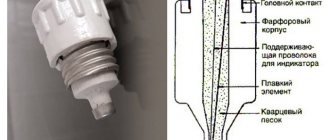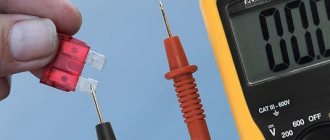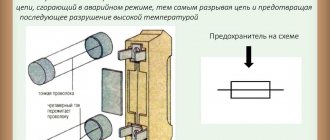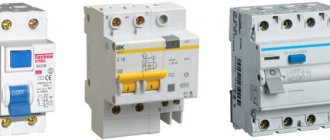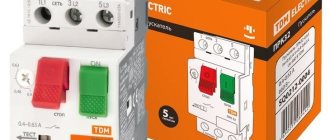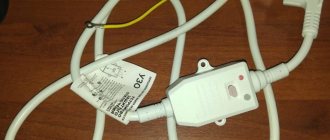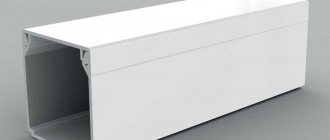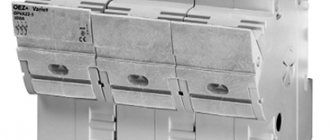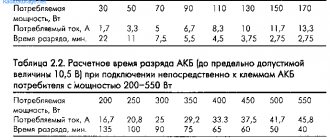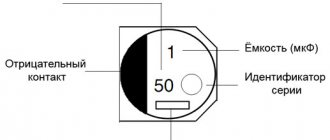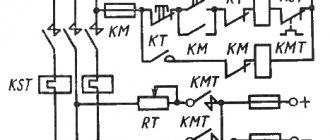Power electronics, which manage kilowatts and megawatts of energy, are unthinkable without appropriate protection measures. Along with complex automated systems, equipment always has a final protective barrier in the form of fuses. The costs that the consumer will incur during subsequent repairs depend on the correct choice of fuse parameters. When replacing a blown fuse, the question of correct selection does not arise, since the specific manufacturer code is indicated in the equipment passport. This article will consider the case when, when developing new equipment or assembling power cabinets, it is necessary to select high-speed fuses based on system parameters, operating conditions, special requirements, etc. Moreover, the determination of the main parameters that influence the selection of fuses will be discussed in more detail - values of rated voltage, rated current, etc.
General calculation rules
In order to make the correct calculation of fuse links, it is necessary to take into account the rated voltage.
This value should be such that the fuse switches off the electrical circuit. The main indicator is the minimum voltage provided for the base and fuse-link. Another important indicator that should be taken into account in the calculations is the shutdown voltage. This parameter is the instantaneous value of the voltage that appears after the fuse or fuse link itself has tripped. As a rule, the maximum value of this voltage is taken into account.
In addition, the melting current must be taken into account, on which the diameter of the wire installed inside depends. When calculating a fuse link, for each metal this indicator has its own value and is selected using a table or calculator. The material and size of the inserts must provide the required protective characteristics. The length of the insert cannot be too long, as this will affect arc extinction and overall temperature characteristics.
The rated load power is usually indicated on the product label. In accordance with this parameter, the rated fuse current is calculated using the formula: Inom = Pmax/U, in which Inom is the rated protection current, Pmax is the maximum load power, and U is the supply voltage.
Switching circuit of the introductory machine
In addition to the main task (ensuring electrical safety), the input switch is designed to disconnect the consumer from the power supply for work. For example, metering device maintenance. Therefore, in most cases the machine is installed in front of the electric meter.
This is the area of responsibility of electricians; the owner of the apartment (household) has no right to interfere. For apartment buildings - this is an entrance shield, for a private house - a pillar, fence, or outer wall of the household. This scheme is used in 90% of residential properties. Between the sealed input machine and the metering device (which also has seals), there is no access for unauthorized connection. This is done to prevent illegal extraction of electricity. Many homeowners install a duplicate input circuit breaker for ease of maintenance and repair of the distribution panel. It is connected between the energy meter and group circuit breakers, and is mounted inside the panel of the apartment (household).
How to choose the right automatic backup machine?
The optimal solution is that the protection current should be less than at the input device and greater than at the group switches. For example, a 32 A circuit breaker is installed at the input, and group circuit breakers are installed at 20 A. This means that the backup must operate at a load current of 25 A. If such a ratio cannot be achieved, the current cutoff of the backup must correspond to the input circuit breaker. In this case, it simply acts as a disconnecting device (for carrying out work). And in an emergency, it will operate simultaneously with the input device.
Selecting wire diameter and fuse repair
Well, now let's move on to the main issue of our article - the choice of diameter and the repair itself. Let's start with the first one.
Conductor diameter selection
The diameter of the conductor in the fuses is clearly calculated. If you are replacing, you must install a conductor of the same diameter. Otherwise, your fuse will not perform its function of protecting the electrical network.
- There are several ways to do this. The easiest way is to take the wire cross-section for the fuse, and a table of standard values will allow you to make a choice. To do this, just measure the diameter of the wire.
- The diameter of the wire can be measured using a caliper or even a regular ruler. If the diameter of the fuse wire is too small, then measurements can be made as follows. We wrap the wire around any small object - a lighter, a pencil, a pen.
- It is advisable to make 10-20 turns for greater measurement accuracy. We make the coils as dense as possible to eliminate the space between them. Then we measure the diameter of all turns. We divide the resulting value by the number of turns. Here is the diameter of the wire for the fuse.
Note! With this method of measuring diameter, you will probably have a small error due to insufficient density of turns. Therefore, we round the resulting number to the nearest smaller number.
- Calculation of a copper wire fuse can also be made for values not indicated in the table. To do this, we need to know the required fuse-link current and wire material.
- In order to calculate the diameter of the copper wire for a fuse up to 7A, we should use the formula below. In this formula, d is the calculated diameter, Ipl is the required fuse-link current, k is a coefficient taking into account the wire material. For copper it is 0.034.
- If you want to calculate the diameter of the wire for an insert with a rating above 7A with your own hands, then you should use the formula given below. In this formula, m is a coefficient that takes into account the wire material. For copper it is 80.
- If the thickness of the wire for the fuse, as a result of calculation or selection from the table, turns out to be one that is not available. Then you can achieve the required diameter by connecting several wires of different sections. Although this option is somewhat worse.
Fuse repair
Installing a wire instead of a calibrated fuse in a fuse is popularly called installing a “bug”. Any “bug,” according to the PUE standards, is unacceptable, since it is not always capable of properly protecting the electrical installation.
Nevertheless, this method of repairing fuses is resorted to quite often. Especially when there is no spare fuse at hand.
- Installing a bug instead of a fuse depends on its type. If this is a tubular fuse with a high rated current, then such products usually have a collapsible design, as in the video.
- That is, the fuse can be untwisted. Remove the burnt-out fuse-link and replace it with a fuse made of copper wire.
- With products of lower denominations everything is a little more complicated. Usually they are made non-separable, and therefore you have to tinker.
- If you have a glass or ceramic type tubular fuse, they usually have metal ends. To install the “bug” they need to be drilled on both sides and our conductor inserted into the resulting cavity. It is advisable to then solder the hole together with the conductor.
- Do-it-yourself repairs with knife fuses are somewhat more difficult. It will not be possible to drill a hole here, since the wire must be attached to the knives, which are hidden under the body. In this case, the wire cross-section of a 10 A fuse or another rating is attached directly to the knives in front of the housing. And then install the fuse.
Note! This method is much more dangerous. Since when a wire burns out, it may splash onto neighboring equipment. This may not lead to a fire, but it can damage the equipment.
- It is for these reasons that our instructions do not recommend winding wire directly onto the fuse holder contacts. The same applies to winding the wire on top of the tubular fuse housing.
Impact of overloads
The maximum current Imax to which a fuse can be exposed depends on the duration and frequency of the overload pulses. According to the duration, overloads are divided into two categories: • overloads lasting more than 1 s; • overload lasting less than 1 s. The table provides basic recommendations for determining the maximum permissible overload current Imax. The melting current is taken from the time-current characteristic of the fuse. Typical examples of load cycles, including overload currents, are shown in Fig. 8.
Let's take, for example, a 200 A fuse that is subjected to 300 A overloads 3-5 times a day, each lasting 5 seconds. For this type of fuse, using the time-current curve, we find that the melting current It, corresponding to an overload duration of 5 s, will be equal to 600 A. From the table we determine that for this type of fuse, the maximum possible overload current is 60% × 600 = 360 A. This means that this fuse can withstand temporary overloads of up to 360 A. Thus, a selected 200 A fuse subjected to an overload of 300 A for 5 seconds 3 to 5 times a day will work correctly.
How to choose power wiring
The power cable must be compatible with the system it powers. If the cable is not thick enough, there will be large losses in it, that is, “sagging,” as this phenomenon is now commonly called. It is due to the fact that the cable has, although vanishingly small, resistance.
It is really very small, about 0.3 - 0.8 Ohm per km of cable length. But it still exists, and at high currents on the line, losses can be noticeable.
Selection of cable cross-section
In order to select a cable of the required cross-section, you do not need to calculate anything. You can, of course, set the current consumption, the permissible drawdown, for example, the current in the system is 100A and the drawdown is no more than 0.5 V, and calculate the required cable cross-section, taking into account the length of the line. This is not necessary. There is an old rule of thumb for selecting the cross-section of a power cable, which for simplicity is called “five amperes per square”:
It is based on the fact that the length of the line from the source to consumers (to amplifiers) does not exceed 5 m. This is 99% of all cases. What does this rule mean? This is the standard for current density. With a current density of five amperes per square millimeter, losses on a cable up to 5 meters long will be no more than 0.5V. Precisely no more than 0.5, this is important at maximum, and not operating, current.
How to use this rule? Take the amplifier and see what its fuse rating is. If there are several, consider the total denomination. If you have several amplifiers and you will power them with one cable, add up the ratings of their preamps. We take the result obtained as the maximum current consumption. The real worker will be noticeably smaller. We divide the maximum current by 5 and get the required cable cross-section (“5A per 1 sq mm).
Next, take the next larger standard cable cross-section. Example. We have an Oris TA-150.4 amplifier. It has a 100A fuse installed on it. Typically, the manufacturer provides a margin of 10-20% when selecting a fuse. Accepts maximum current for 100A. Divide 100 by 5 to get 20 squares. To power such an amplifier you will need a cable with a cross-section of at least 20 sq mm. We select the following standard cable cross-section - 25 sq mm. All. To power the Oris TA-150 amplifier.
4, a cable with a cross-section of 25 square millimeters is necessary and sufficient. You can use a cable that is one section larger, and it won’t be any worse. Will it be better? Practice shows that if you take a cable two or more sizes larger, it will definitely not be better. Losses on the cable are already approaching zero.
Use the “five amperes per square” rule, select the required cable cross-section or one size larger. Buying a thicker cable will not be advisable.
The drawdown lives not only on the cable. And, for example, also on the fuse.
Fuse selection
A fuse on the power line must be required and must be installed not far from the power source. In an emergency, it must protect the power source from short circuit. It doesn’t matter what happened, the cable frayed and shorted to ground, or the amplifier burned out and somehow shorted it. The fuse must blow to prevent the wiring from catching fire.
The operating principle of a fuse is simple and is based on Ohm's law for a complete circuit.
Where Un is the voltage drop across the system elements: at the wiring, at the limiter, at the amplifier itself, etc.
These are all dips of their kind, but we don’t call the voltage drop across the amplifier that way. The magnitude of the voltage drop depends directly on the resistance of the system element and is always many times less than the voltage drop on the main link - the amplifier. So far so good, the losses on the cable and fuse are not significant, everything works. Now let’s imagine that some emergency has occurred. The wiring has shorted.
Of all the elements of the system connected to the power source (battery), only the power cable and fuse remain (the amplifier has fallen out of the system). And all its energy will be dissipated precisely on the cable and at the limit. Which one will burn out first, the wire or the front? For a fuse to blow, the drawdown on it must be much greater. Then it will work stably. Therefore, the fuse must be selected strictly according to the cable.
Not by current consumption, but specifically by cable cross-section.
The fuse rating is also selected according to the “five amperes per square” rule. Only in the opposite direction. Let's say you need to select a fuse for a cable with a cross-section of 25 squares, which powers the same Oris TA-150.4 amplifier. Multiply 25 by 5, we get the required rating of 125A. The next larger one is rated 150A.
If the power wiring is selected according to the described rule, the system operates stably, with a good margin, and in the event of a short circuit, the fuse operates clearly. Cable and fuse losses are very small. There is no need to remove the fuse. This is sometimes done in competitions to reduce drawdown. But we don’t need this at all for everyday use.
Application areas for fast-blow fuses
The widespread use of power semiconductor converters has determined the growth in the use of high-speed fuses. Power semiconductor converters are used for economical conversion of electrical energy in the automation of production processes, mechanization of pipe rolling and pipe electric welding industries, power supply and control of compressors and pumping stations of oil and gas pipelines, and the mining industry. Let us dwell on the specifics of the use of high-speed fuses in certain industries.
Bussmann has specially developed solutions for applications in rail and electric vehicles. The specificity is determined primarily by the use in DC circuits for a wide range of currents and voltages. We have already discussed the features of application in DC circuits above, in particular, due to the more complex process of extinguishing the arc, the use of higher quality materials and an increase in the physical dimensions of the fuse are required. A special feature of traction converters for electric rolling stock is also their operation under conditions of continuous mechanical influences, cyclic current overloads, high load inductance, and a wide range of climatic factors, which imposes stricter requirements on the fuses used. In the line for railway and electric transport, Bussmann has fuses for traction converters, control and monitoring systems, voltage converters, auxiliary systems of rolling stock (Fig. 15).
Fig. 15. Application of Bussmann fuses in rolling stock circuits.
Another typical area of application for Bussmann high-speed fuses is the metallurgical industry.
Steel production in arc steel furnaces requires currents of up to 100 kA at voltages of more than 1000 V. The process of chlorine electrolysis requires constant currents of up to 300-350 kA and voltages of up to 1000 V DC. Copper, zinc, lead, nickel, cadmium, etc. are also produced using high currents. To power electrolysis baths in non-ferrous metallurgy, power rectifier units are used with a rated current of up to 100 kA at a voltage of up to 1000 V. These units are characterized by a large number of parallel-connected rectifier modules and the need to ensure power continuity. In some cases, during an accident caused by a single failure of a semiconductor module, when the emergency current reaches 150-200 kA, an arc may form, accompanied by an explosion. Explosions of semiconductors caused by the absence or poor quality of protective devices lead to serious consequences - destruction of the converter structure, disruption of complex technological processes, and expensive repairs. The fast-acting fuse is designed to operate in a timely manner and turn it off in the event of a breakdown of the corresponding semiconductor (thyristor, IGBT) connected in series with it, and this should not critically affect the operation of the converter. To meet the growing demand for current carrying capacity, Bussmann has developed a size 5 fuse in a single design that optimizes the fuse temperature for both forced air and single- or double-sided water cooling (Fig. 16).
Fig. 16. Special fuses Bussmann size 5 for the metallurgical industry.
Another rather specific application of Bussmann fuses is solar energy equipment (Fig. 17). Solar power generation systems consist of arrays of photovoltaic cells and inverters. Fuses are used both to protect solar panel cell strings, subarrays and arrays, and to protect associated inverters. Features of solar energy - high DC voltage, low output current, very low short circuit currents, sensitivity to overvoltage damage - also determine the specificity of protective devices. Bussmann produces a full range of fuses for solar system equipment. The range includes cylindrical fuses with different contact designs to protect photocell lines (10x38mm 600V, 14x51mm 1000V/1100V, 14x65mm 1300/1500V DC), as well as rectangular fuses of different sizes for 1000/1500V DC to protect entire arrays. The range also includes various holders and other accessories. Fuses with the gPV characteristic are capable of tripping at a current of only 1.3 times the rated current, which is their characteristic feature.
Fig. 17. Fuses with gPV characteristic for protecting solar panels.
It is also worth recalling the widespread use of high-speed fuses in the protection circuits of semiconductors of frequency converters, soft starters, electric motor drives used as part of production equipment in various industries, uninterruptible power supplies, voltage converters, equipment for alternative energy sources, etc.
You can select and buy a fuse of the required rating in the online store bussfuse.ru (Iteks LLC). Bussmann is the world's leading company in the number of fuse models produced and also offers the widest range of high-speed fuses on the world market. Our company is the official representative of Bussmann in the Russian Federation, so when ordering from us you can be sure that the fuses you purchase are original Bussmann products.
Authors
- Vitaly Khaimin
- Ruslan Cherekbashev
Fuse Types
According to their purpose and design, fuses are of the following types:
- Plugs (mainly used to protect electrical wiring and devices in cars);
- With low-current inserts to protect electrical appliances with current consumption up to 6 amperes;
- Cork (installed in panels of residential buildings, designed for protection current up to 63 amperes);
- Knife type (used in industry to protect networks with current consumption up to 1250 amperes);
- Gas generating;
- Quartz.
The repair technology discussed in the article is intended for restoring fork fuses, with low-current inserts, plug and blade type fuses.
Tubular fuses
A fuse of a tubular design is a glass or ceramic tube, closed at the ends with metal caps, which are connected to each other by a wire of calibrated diameter running inside the tube. You can see the appearance of tubular fuses in the photograph.
The wire is spot welded to the caps or soldered with solder. In fuses designed for very high currents, the cavity inside the tube is often filled with quartz sand.
Automotive fuses
Fuses in cars rarely fail. Usually only in cases where the equipment fails. Most often when the headlight bulbs burn out. The fact is that when the filament of a light bulb breaks, a Voltaic arc is formed, the filament burns out and becomes shorter, the resistance sharply decreases and the current increases many times over.
It happens that a fuse in a car burns out when the windshield wipers jam. Less often during short circuits in electrical wiring. In the photo you see widely used automotive blade (fork) type fuses. Below each fuse is the current of its protection in amperes.
A blown fuse in a car should be replaced with a fuse of the same rating, but it can also be repaired by replacing the blown wire in the fuse with a copper wire of the appropriate diameter. The voltage of the car's on-board network does not matter. The main thing is the correspondence of the protection current. If it is difficult to determine the rating of a blown car fuse, then you can use color coding.
Homemade fusible link from a conductor, selection by cross-section
Under no circumstances should you accept making your own fuse links FOR THE NORM. Installation of such products can be considered as a TEMPORARY MEASURE.
Diameters of COPPER wire for fuse link
| Diameter, mm | Current, A | Diameter, mm | Current, A |
| Ø 0.05 mm | 0.6 A | Ø 0.71 mm | 47.8 A |
| Ø 0.063 mm | 1.25 A | Ø 0.75 mm | 52 A |
| Ø 0.071mm | 1.5 A | Ø 0.8 mm | 57.2 A |
| Ø 0.08 mm | 1.8 A | Ø 0.85 mm | 62.7 A |
| Ø 0.09 mm | 2.1 A | Ø 0.9 mm | 68.3 A |
| Ø 0.1 mm | 2.5 A | Ø 0.95 mm | 68.6 A |
| Ø 0.112 mm | 3 A | Ø 1.0 mm | 80 A |
| Ø 0.124 mm | 3.5 A | Ø 1.06 mm | 87.3 A |
| Ø 0.14 mm | 4.2 A | Ø 1.12 mm | 94.8 A |
| Ø 0.16 mm | 5.1 A | Ø 1.18 mm | 102.5 A |
| Ø 0.17 mm | 5.6 A | Ø 1.25 mm | 111.8 A |
| Ø 0.18 mm | 6.1 A | Ø 1.32 mm | 121.3 A |
| Ø 0.2 mm | 7.1 A | Ø 1.4 mm | 132.5 A |
| Ø 0.224 mm | 8.4 A | Ø 1.45 mm | 139.7 A |
| Ø 0.25 mm | 10 A | Ø 1.50 mm | 147 A |
| Ø 0.28 mm | 11.8 A | Ø 1.6 mm | 161.9 A |
| Ø 0.315 mm | 14.1 A | Ø 1.7 mm | 177.3 A |
| Ø 0.335 mm | 15.5 A | Ø 1.8 mm | 193.2 A |
| Ø 0.355 mm | 16.9 A | Ø 1.9 mm | 209.5 A |
| Ø 0.4 mm | 20.2 A | Ø 2.0 mm | 226.2 A |
| Ø 0.45 mm | 24.1 A | Ø 2.12 mm | 247 A |
| Ø 0.5 mm | 28.2 A | Ø 2.24 mm | 268.2 A |
| Ø 0.56 mm | 33.5 A | Ø 2.36 mm | 290 A |
| Ø 0.63 mm | 40 A | Ø 2.5 mm | 316.2 A |
| Ø 0.67 mm | 43.7 A |
For repairing fuses with protection current from 0.25 to 50A
| Fuse protection current, Ampere | 0,25 | 0.5 | 1.0 | 2.0 | 3.0 | 5.0 | 7.0 | 10.0 | 15.0 | 20.0 | 25.0 | 30.0 | 35.0 | 40.0 | 45.0 | 50.0 | |
| Wire diameter, mm | Copper | 0.01 | 0.02 | 0.04 | 0.07 | 0.10 | 0.18 | 0.20 | 0.25 | 0.32 | 0.39 | 0.46 | 0.52 | 0.58 | 0.63 | 0.68 | 0.73 |
| Aluminum | — | — | 0.07 | 0.10 | 0.14 | 0.19 | 0.25 | 0.30 | 0.40 | 0.48 | 0.56 | 0.64 | 0.70 | 0.77 | 0.83 | 0.89 | |
| Steel | — | — | 0.32 | 0.20 | 0.25 | 0.35 | 0.45 | 0.55 | 0.72 | 0.87 | 1.00 | 1.15 | 1.26 | 1.38 | 1.50 | 1.60 | |
| Tin | — | — | 0.18 | 0.28 | 0.38 | 0.53 | 0.66 | 0.85 | 1.02 | 1.33 | 1.56 | 1.77 | 1.95 | 2.14 | 2.30 | 2.45 | |
For repairing fuses with protection current from 60 to 300A
| Fuse protection current, Ampere | 60 | 70 | 80 | 90 | 100 | 120 | 160 | 180 | 200 | 225 | 250 | 275 | 300 | |
| Wire diameter, mm | Copper | 0.82 | 0.91 | 1.00 | 1.08 | 1.15 | 1.31 | 1.57 | 1.72 | 1.84 | 1.99 | 1.14 | 2.20 | 2.40 |
| Aluminum | 1.00 | 1.10 | 1.22 | 1.32 | 1.42 | 1.60 | 1.94 | 2.10 | 2.25 | 2.45 | 2.60 | 2.80 | 2.95 | |
| Steel | 1.80 | 2.00 | 2.20 | 2.38 | 2.55 | 2.85 | 3.20 | 3.70 | 4.05 | 4.40 | 4.70 | 5.0 | 5.30 | |
| Tin | 2.80 | 3.10 | 3.40 | 3.65 | 3.90 | 4.45 | 4.90 | 5.80 | 6.20 | 6.75 | 7.25 | 7.70 | 8.20 | |
The best models of automatic fuses
Russian models
The Russian industry for the production of automatic fuses has recently made a big leap. New technologies for manufacturing cases are used. The contact group is meeting in a new way. Improved design. For individuals and businesses, the choice of introductory machines has become much wider and the quality is no worse than the best European brands.
Contactor
Rating: 4.7
The domestic enterprise “Kontactor” is in first place in our ranking. The plant initially made classic automatic machines. Now it is reoriented to industrial designs of 380 V. The company’s line also includes a household series “KPRO” with support for current up to 100 A. But basically the “Contactor” specification is industrial samples for electric motors designed for current up to 1600 A, which should protect industrial equipment. The Proton line also includes models of the three-phase Electron circuit breaker with a rating of 6300 A.
Advantages
- models are equipped with regulation of operation during short circuit or overload;
- a wide range of automatic machines from 16 to 6000 A;
- All products are certified for sale in the Customs Union.
Minuses
- the design is not very well developed;
- There are very few switches for household use;
- high cost of models;
- the mounting contacts are not recessed into the automatic fuse.
KEAZ
Rating: 4.7
A factory with history. The company opened back in 1945. It produces both classic machines and devices of the KEAZ Optima brand, in which one can notice new machine capacities and know-how.
They produce machines for both alternating current and direct current. All electrical equipment adjusters note the good design of the devices and the ease of their installation. If you are choosing which machines to install in a private home, this is the place for you.
Advantages
- there are different types - you can choose protection for different lines that use both direct and alternating current;
- acceptable price;
- compact design.
Flaws
short service life (1–2 years).
DEKraft
Rating: 4.6
Electric machines under the general brand DEKraft are produced at the Russian enterprise Delixi Electric. These products are widely known not only in Russia and the CIS but also abroad.
True, in Europe they are better known by a different name - Himel. Mainly concentrated in China for reasons of reducing the cost of final products.
This policy made it possible to reduce the price of the machine and extend its service life. It was announced that the circuit breaker will withstand at least 6000 contact opening cycles during a short circuit. And with a slow increase in load, when the wiring is already starting to heat up, the circuit breaker can disconnect the electrical circuit at least 25,000 times!
Advantages
- all company enterprises have passed international certification;
- wholesale supply is well established in all regions of Russia;
- it is easy for the buyer to understand which machine is in front of him - all the signatures are in Russian.
Flaws
- maximum current 63 A;
- The maximum permissible cross-section of supply cables is 25 mm².
The best foreign companies
Foreign brands are still popular in our country. It is believed that these are higher quality and durable products. Therefore, our review presents products from foreign manufacturers.
ABB
Rating: 4.9
This bright red acronym is well known to professional electricians due to its wide range of circuit breakers from 0.5 to 100 A.
Both ordinary users and professionals note the reliable plastic case and control lever, which will not break off even after repeated off/on cycles. It’s not for nothing that professional electricians choose these circuit breakers for apartment switchboards.
Advantages
- The dimensions of the breaker body allow it to be easily installed in the panel;
- high level of security;
- ease of installation;
- You can also purchase four-pole models of circuit breakers.
Flaws
- high cost;
- DIN rail mounts are quite fragile;
- no or few type D devices.
Legrand
Rating: 4.8
In the catalog of the French company, you can choose machines of the DRX series - corresponding to the load for industrial use and the DX, RX, TX series for domestic use. The housings of the devices in the apartment are dustproof.
Current ratings range from 6 A to 630 A, including 125, 260, 320 and 400 A. Such a wide range allows you to select a fuse for both domestic needs and large-scale industries.
Advantages
- there are machines with poles from 1 to 4;
- There is a laser barcode on the case.
Flaws
- rarely, but there are models with defects;
- the toggle switch is carelessly executed;
- high cost.
Replacing the fuse
When replacing a fuse, to avoid electric shock, be sure to unplug the electrical appliance!
There is an unspoken rule: if after the second replacement the fuse blows again, look for a fault in the electrical appliance itself. This means that the electrical appliance needs to be repaired.
Do not install a fuse at a higher current under any circumstances; such attempts will definitely lead to even greater damage to the device, up to the point of its being beyond repair!
Be careful when purchasing a new fuse. Correctly determine the type and current rating of the replacement candidate. It is better to purchase electronic components from trusted suppliers who guarantee product quality, such as Conrad Electronic.
Let's take the guide...
If you have a reference book on insulating materials, the task is greatly simplified. In this case, they start with construction definitions:
- Amounts of heat - energy given or received over a certain period of time (see above). In construction it is measured in W s (and in physics - in joules).
- Thermal conductivity is a quantity that shows how much energy (W s) passes per unit time (s) through one square meter of surface (sq.m = mm) through a unit of floor thickness (m) at a unit temperature difference (K or degree Celsius). The unit looks like this: W s m/s sq.m K = W/m K.
- The heat transfer coefficient (thermal conductivity) is calculated as thermal conductivity divided by the thickness of the ceiling. Unit of measurement: W/sq.m K.
- Heat transfer resistance is the reciprocal of the heat transfer coefficient of the material. Sometimes the meaning may appear in the context of thermal insulation. Then the ratio of quantities can be determined by the unit of measurement given above.
- Heat transfer resistance coefficient is the reciprocal of the heat transfer coefficient.
- The heat transfer coefficient shows how much energy (W s) per second is exchanged per square meter (sq.m) of surface when there is a temperature difference of 1 K (K or degree Celsius) between the surface of the material and the air. Unit of measurement: W/sq.m K.
- Heat transfer resistance (surface) is the reciprocal of the heat transfer coefficient.
- The density of a material shows how many kg 1 cubic meter of a substance weighs. An important parameter, polyvinyl chloride foam is much lighter than the insulation of the PV-1 wire. In the absence of data on the latter, an attempt is made to approximate the value.
- The moisture content of the material in this particular case does not play a role. Unless there is a damp wall around, then the fact is taken into account according to the situation.
The overall heat transfer coefficient is thus made up of three components:
- Heat transfer to the fence from the source (wire).
- The passage of heat through the cambric insulating material.
- Heat transfer from the outer surface of the cambric to the surrounding space.
The unit of measurement is still W/sq.m K. The indicated value must be calculated according to the reference data found. Then divide the area of cambric in the area under consideration by it. The resulting figure is multiplied by the unknown temperature difference and equated to the power found from the Joule-Lenz law. The climatic conditions of the room are assumed to be known. This is how the expected temperature of the cable core is obtained at a known consumed electric current.
The obtained value is compared with the operational data of the wire. If the temperature is higher than normal, the current must be reduced, or a different wire should be selected (with a thicker core or a different type of insulation).
Fuse repair
Typical people believe that fuses cannot be repaired; in fact, this is not the case. Most types of fuses can be repaired and given a second, third, etc. life. The fuse housing, as a rule, is destroyed extremely rarely, the wire inside burns out, and the repair consists of replacing it. The main task is to use a wire similar to the one in the fuse.
If you need to replace a fuse very quickly, but you don’t have a spare at hand, you can use the following method:
Remove the paint coating from a wire of a suitable diameter (clean it until it shines) and wind several turns around each fuse contact, then insert the fuse into the holder. This method is popularly called “bug”. With its help you can very quickly check the serviceability of the device, but it is not reliable and can be used as a temporary solution to the problem.
The next method is the so-called “factory” one. Repairs will require a soldering iron, and perhaps a Dremel or screwdriver, but the fuse after repair will look like it came straight from the factory.
Heat the ends of the cup contacts with a soldering iron and remove the solder from the holes in the ends using a toothpick or something similar. It happens that the holes are too small or completely absent, then you will have to drill them. Use a drill of small diameter 1 - 2 mm.
Pass a wire of a suitable diameter through the holes and solder it to the cup contacts.
The fuse is ready!
Circuit breakers or fuses in front of the SPD
To maintain uninterrupted power supply in the house, it is also necessary to install a circuit breaker that will turn off the surge protector. The installation of this machine is also due to the fact that at the moment the pulse is removed, a so-called accompanying current arises.
It does not always allow the varistor module to return to the closed position. In fact, it does not recover after being triggered, as in theory it should.
As a result, the arc inside the device is maintained and leads to a short circuit and destruction. Including the device itself.
In the event of such a breakdown, the machine is triggered and de-energizes the protective module. Uninterrupted power supply to the house continues.
At the same time, many experts recommend installing not even a machine, but modular fuses as such protection.
This is explained by the fact that the machine itself during a breakdown is exposed to a pulsed current. And its electromagnetic releases will also be under increased voltage.
This can lead to breakdown of the trip coil, burning of contacts and even failure of the entire protection. In fact, you will find yourself unarmed in the face of a short circuit.
Therefore, installing an SPD after a machine is much worse than after fuses.
There are, of course, special automatic switches without inductors, which have only thermal releases in their design. For example Tmax XT or Formula A.
However, considering this option for cottages is not entirely rational. It is much easier to find and buy modular fuses. In this case, you can choose the GG type.
They are capable of protecting over the entire range of overcurrents relative to the rated ones. That is, if the current has increased slightly, GG will still turn it off at a given time interval.
There is, of course, a minus to the circuit with a machine or PC directly in front of the SPD. We all know that thunderstorms and lightning are long-term, not one-time phenomena. And all subsequent impacts may be unsafe for your home.
The protection had already worked the first time and the machine gun was knocked out. And you won’t even guess about it, because your power supply was not interrupted.
Therefore, some people prefer to install an SPD immediately after the input circuit breaker. So that when triggered, the voltage in the entire house is turned off.
However, there are pitfalls and rules here too. The protective circuit breaker cannot be of any rating, but is selected according to the brand of the SPD used. Here is a table of recommendations for choosing circuit breakers mounted in front of surge protection devices:
If you think that the lower the nominal value of the machine is installed, the more reliable the protection will be, you are mistaken. The pulse current and voltage surge can be of such magnitude that they will lead to the circuit breaker tripping even before the SPD operates.
And accordingly, you will again be left without protection. Therefore, choose all protective equipment wisely and according to the rules. SPD is a quiet, but very timely protection against dangerous electricity, which comes into operation instantly.
Calculation of fuse wire diameter
To repair the fuse, it is necessary to replace the burnt wire. In the production of fuses in factories, depending on the current value and speed, calibrated silver, copper, aluminum, nickel, tin, lead and wires made of other metals are used.
For making a fuse at home, only red copper of calibrated diameter is available. All electrical wires are made of copper, and the more elastic the wire, the thinner the conductors and the greater the number of them. Therefore, all the technology proposed below is focused on the use of copper wire.
When choosing a fuse for equipment, developers use a simple law. The fuse current must be greater than the maximum consumed by the product. For example, if the maximum current consumption of the amplifier is 5 amperes, then the fuse is selected at 10 amperes. The first thing you need to do is find its marking on the fuse body, from which you can find out what current it is designed for. Often the current value is written on the product body, next to the location where the fuse is installed. Then, from the table below, determine what diameter wire is needed.
Voltage relay DigiTOP
The relay has an attractive appearance.
No extra fidgety switches. Digital display and three function buttons. The first one - when pressed briefly, shows the lower response limit, the third - the upper one. To change the factory parameter (Umin=170V - Umax=250V), keep the button pressed for several seconds. If you press the first and third keys simultaneously, the restart time delay settings will appear. The middle button plays an informative role and shows the voltage due to which the relay was activated.
When you connect to the network for the first time, the readings on the display begin to flash. This means that the relay is open and there is no U at the output. After 15 seconds, at normal supply voltage values, the relay will automatically operate and turn on.
The specified reading error is a maximum of 5 Volts.
To switch to the voltmeter setting mode, with the device's power off, press both buttons and turn on the power. The indicator will display a certain voltage value at the device input and the dots at the bottom of each digit will blink. Next, using the “MORE” or “LESS” buttons, you can set the required voltage value according to the reference device. To exit this mode, you must turn off the power.
The price of the most popular 220V relay model for apartments with current up to 40A is within 3,000 rubles.
V-Protector brand – protects only from power surges.
If it is clamped on both sides by automatic devices, the heat transfer will sharply decrease and at rated currents it will falsely turn off.
- normal operation is maintained at temperatures from +5C. Therefore, the relay is only for installation inside the apartment and no switchboards in the entrances.
- single and three-phase version
- rated currents from 16A to 63A
Connection diagram:
The VA-Protector series is a current relay and a voltage relay combined into one.
- triggered when the current load is exceeded
- rated currents from 32A to 63A
- if the current exceeds the rated current, it will turn off the load within 10 minutes. If the maximum (short circuit) - in a time of 0.04 seconds.
- The relay screen displays both voltage and load (in amperes)
There is also a DigiTOP MP-63 relay. The difference lies in the display of the load value in kW in addition to voltage and current.
The connection diagram is similar to the above.
To summarize the above, here is what you should pay attention to first of all when choosing a 220V voltage relay for your home or apartment:
- connects directly or paired with a contactor
- how many modules occupies in the electrical panel
- rated current
- clarity and ease of settings and connections
- operating temperature (where you will install it - street, entrance, apartment)
- functionality (thermal protection, current protection)
- wire cross-section for terminal clamps
- price
Operating principle of fuses
The principle of operation of disposable protective devices is very simple. Inside each of them there is a calibrated wire connecting the contacts. If the current value does not exceed the maximum permissible norms, it heats up to approximately 70 degrees. When the electric current exceeds the set rating, the heating of the wire increases significantly. At a certain temperature it begins to melt, resulting in a break in the electrical circuit. Wiring burnout occurs almost instantly. Because of this, fuses got their name - fuse link.
In different designs, the fuse link is selected in such a way that operation occurs at the set current value. During operation, fuses periodically fail and must be replaced. As a rule, they are not repaired, but many home craftsmen quite successfully restore them.
Since only the wire itself burns out, but the body remains intact, it is necessary to replace it and the device will continue to perform its functions. New technical characteristics are often not only not inferior to the old device, but also in many ways superior to it, since the quality of hand assembly is always higher than the factory one. The main condition is the correct choice of conductor material and calculation of its cross-section.
Features of replacing a circuit breaker in a panel
Now we’ll figure out how to replace plugs with automatic ones, which will improve electrical safety and protect the wiring from high currents. At the moment, plugs are no longer produced, and therefore users have replaced the old wire with a new, thicker and more reliable one, but in any case, the wiring remains unprotected. Electrical meter plugs are increasingly being replaced by automatic ones, as more powerful household appliances with the corresponding requirements are used. Even a novice electrician can cope with this task.
Before starting work, you should turn off the power to the electrical network. PUE prohibits working with electricity meters and other energized devices. It happens that it is not possible to turn off the voltage, but a replacement needs to be made. Here you should familiarize yourself with the design of the shields, which come in several types.
If we are talking about an access panel, then each apartment has its own package switch, meter and two plugs (phase and zero). To relieve the voltage in such a panel, the package switch is turned off. The apartments have a meter mounted on a carbolite base. Above it there are two plugs: phase and zero. To relieve the voltage, just unscrew the phase.
Replacing the fuse
If the traffic jams still cannot be turned off, there is a certain sequence of actions for such work. First, the plug through which the phase passes is determined. To do this, you will need to remove the protective casing from the device and use a voltage indicator to check.
A phase wire comes from the meter, located on the top terminal of the plug. On the second plug there is a zero. The phase wire, or rather its fastening, is carefully unscrewed using an insulated screwdriver, and then moved to the side.
Important! This wire remains live, so insulation is required. If it is not long enough, a terminal block is put on it, which does not require insulation
All the wires are unscrewed from the plugs, of which there are only 4. To select a suitable machine, you need to rely on the cross-section of the wire. If it is an aluminum wire with a cross-section of 2.5 mm², then the machine should be 16A, if 4mm² - 25A. If large household appliances, for example, a washing machine, are installed in the room, it requires a separate circuit breaker, as well as RCD protection.
Next, in a specialized store, 2 16A circuit breakers and a 40A RCD are selected. For automatic machines and RCDs, a small panel with a bus for the working zero is sufficient. The shield is fitted to the carbolite base, after which the holes are marked and drilled.
The supplied wires must be prepared in advance and extended using a terminal block. The upper and lower wires from the zero plug are attached to the zero bus. A live wire is connected to the left machine. A piece of the required length is added to the terminal block and wound into the machine. The washing machine machine is connected to the upper terminal of the second fuse via a loop.
Every year in Russia, all sorts of accidents occur due to the fact that power lines or equipment are malfunctioning. This can be avoided, but it is necessary to include reliable, high-quality protective equipment into the project during the design and maintenance process. Automatic fuses are also installed in apartments, and how to change plugs is written above. When choosing a device, you should know the basic parameters and nuances, then the electrical wiring will not cause problems during operation in the future.
Causes of blown fuses
Let's start with the most important thing - the reasons for blown fuses. After all, nothing just happens, and before installing a bug, you need to determine the reasons for the fuse failure.
There may be several of them:
Fuse links. How to choose and calculate current. Operation and Application
Fuse links are electrical elements for protecting equipment from short circuits and overvoltage by turning off power when current load limits are exceeded. Opening the circuit occurs due to the melting of a safety wire of a certain thickness. Several types of these devices are known to the industry. They all differ in internal and external design features, but function according to the same principle.
Nowadays, in order to protect household electrical equipment, more practical reusable circuit breakers are used, but disposable fusible links are still found in plugs. They are especially relevant for premises of temporary and old buildings, where the installation of effective modern shields is not economically justified. In household appliances, there is still no alternative to the classic fuse.
Fuse links are also actively used in industry. The performance of an entire plant or utility network may depend on them. It is better not to buy industrial fuses secondhand, on the market or from unverified organizations. A wise decision is to turn to electronics professionals, for example, the online store Conrad.ru. In such matters, the miser pays not twice, but three times
Where to get the resistance values of materials to heat transfer
If you couldn’t find a specialized construction reference book or a suitable table, there will be a solution. It’s easy to notice that there is a lot of data on the Internet for window profiles, but it’s unlikely to find the necessary data on PVC. It is suggested to find a good online calculator on the Internet to calculate heat losses through ceilings.
The program written in a network language (JAVA, PHP) allows you to calculate thermal conditions for complex structures. And in many cases it will give a ready answer. You need to check the result in at least three places; selected calculators outright lie. Moreover, reliability testing should be carried out using a simple example: wood or brick. In complex things it is easy to make mistakes yourself.
The calculator has a built-in reference book, which shows the resistance of a number of insulation materials. And this will certainly help in the calculations. When choosing materials, you need to consider density. For example, PVC-1 foam plastic exhibits (according to smartcalc.ru data) a density of both 10 and 125 kg per cubic meter. It is clear that the characteristics of the materials are very different.
We choose the diameter of the fuse wire - we analyze all the subtleties of the issue
A homemade copper wire fuse can be a great temporary way to replace a blown fuse. But if you decide to do this, then it is extremely important to choose the right cross-section of the very conductor that you will use. Why is this important, what are the reasons for blown fuses and ways to temporarily eliminate this inconvenience we will consider in our article.
How to determine the fuse rating from the case and on the board
Before you change something that has gone bad, you need to understand what has gone bad. In our case it burned out. Here you can rely only on the inscription on the board itself or on the fuse, because other methods of finding out what the fuse rating was are very unsteady and groundless. After all, a serviceable fuse will not show anything as zero resistance, but a faulty break. At the same time, do not send it to the laboratory for analysis in order to find out what kind of material it was. Let's look at examples of designation of fuses on the board and SMD elements. By the way, sometimes even a resistor can be used instead of a fuse.
conclusions
To keep your circuit from melting and catching fire, it never hurts to install a fuse at the input. For large electrolytic capacitors in some inexpensive consumer products, the current-carrying traces on the circuit boards are smaller, so that when the capacitor shorts, the traces on the circuit board melt, serving as a fuse. However, this is not the best solution since copper has a high temperature coefficient and the PCB manufacturing process does not control the needs of your temporary copper fuse.
You're better off installing small surface mount fuses that operate more predictably. This way, when a technician replaces "broken" electrolytic capacitors, he or she can solder a new fuse. With fast delivery, capacitors and fuses can be ordered during lunch and will arrive at 10:00am the next day. Better yet, there will be no traces of molten metal on the printed circuit board (PCB). If they are repaired with a bus wire, the melting current will be too high, and the product may ignite the next time the electrolytic capacitor breaks down.
Calculation of conductors for fuses
where: d – conductor diameter, mm; k – coefficient depending on the conductor material according to the table.
where: m is a coefficient depending on the conductor material according to the table.
Formula (1) is applied for low currents (thin conductors d=(0.02 - 0.2) mm), and formula (2) for high currents (thick conductors). Odds table.
The conductor diameter for use in a fuse is calculated using the formulas: For low currents (thin conductors with a diameter of 0.02 to 0.2 mm):
For high currents (thick conductors):
The amount of heat generated at the fuse link is calculated by the formula:
where: I – current flowing through the conductor; R – conductor resistance; t – time the fuse-link is under current I.
The resistance of the fuse link is calculated by the formula:
where: p – resistivity of the conductor material; l – conductor length; s is the cross-sectional area of the conductor.
To simplify calculations, the resistance is assumed to be constant. The increase in resistance of the fuse link due to increased temperature is not taken into account.
Knowing the amount of heat required to melt the fuse link, you can calculate the melting time using the formula:
where: W is the amount of heat required to melt the fuse link; I—melting current; R is the resistance of the fuse link.
Estimation of fuse response speed
Once you have selected your fuse package, perhaps part of this effort is to ensure that the fuse link's tripping speed meets the requirements of your application. A fast-blow fuse will burn quickly before the wires or traces on the circuit board have time to heat up. However, rapid burnout can cause a nasty crash due to momentary overload.
Incandescent lamps, capacitive loads, and linear and switching power supplies have a large current pulse when turned on. The problem is a little more complicated for AC-powered loads, since the AC inrush at turn-on may be less severe if the turn-on timing coincides with the voltage zero crossing. You must also consider the condition when you connect the power at the moment of the voltage peak value. This will create a short but significant current pulse that can burn the fuse-link.
What do copper wire fuses look like and do?
In appearance, a fuse is a glass or ceramic flask with a calibrated copper wire stretched inside it. It is attached to the element contacts located in the metal caps using soldering or spot welding. The diameter of the wire depends on the current for which the fuse is designed. The flask (tube) of a product with a high rated current is sometimes filled with quartz sand. Because of their appearance, such fuses are called tubular.
Another common type of this device is knife-type automotive fuse links. Depending on the current rating, they are painted in different colors:
- 5 A - orange;
- 7.5 A - brown;
- 10 A - red;
- 15 A - blue;
- 20 A - yellow;
- 25 A - colorless (transparent);
- 30 A - green;
- 40 A - purple;
- 60 A - blue;
- 70 A - black.
The operating principle of the insert is extremely simple. The fuse is turned on and electric current begins to flow through the wire. The wire heats up. As long as the current does not exceed the fuse rating, the wire temperature remains at approximately 70 degrees Celsius. As soon as the current values exceed the permissible limits, the heating of the wire increases to the melting temperature of copper, it loses its integrity, thus breaking the electrical circuit. All this happens very quickly, almost in a split second. It is because of this principle of operation that fuses with copper wire are called fuse links.
There are different types and types of such inserts. But regardless of this, they all act the same way: the copper wire they contain melts and the current flow is interrupted.
It is very important to understand that the fuse “trips” precisely when the permissible current value is exceeded, but the voltage in the network has no meaning for it. In other words, the same element can be installed in both a 12-volt charger and a single-phase or three-phase network.
Naturally, the question may arise: we say that the device protects against power surges in the network, and then we claim that voltage is not important for it, how is this possible? In fact, here it is enough to recall the school physics course, namely Ohm’s law, which states that the current strength in a section of a circuit is directly proportional to the voltage and inversely proportional to the resistance. In other words, the higher the voltage, the higher the current, given that the resistance of the conductor (copper wire of a certain diameter) in any case remains unchanged.
An insert can burn out not only due to voltage surges in the network, that is, due to exceeding the rated current, but also due to a malfunction inside the device itself in which it is installed. You can determine the reason for the failure of the insert yourself - if after replacing it twice, the element burns out again, it means that the device itself is faulty. Sometimes a situation occurs when the reason for the failure of an insert is its poor quality, but this is rare.
AC fuses in DC circuits
With that in mind, let's look at an example of testing the suitability of a particular fuse in a DC circuit. The information below applies specifically to the 660, 690, 1000 and 1250 VAC standard series rectangular fuses. However, in the catalog there is no information for them about the possibility of their use in DC circuits. However, these fuses can be used in circuits where DC voltage is used. However, it is necessary to carry out a certain verification calculation.
The breaking capacity of the fuses depends on the combination of:
-maximum applied constant voltage;
- time constant of the L/R circuit; — minimum expected short circuit current Ipmin of the circuit;
— pre-arc integral I2t of the selected fuse.
Calculation example.
Background information:
We use the parameters of a specific fuse 170M6149: 1100A, 1250 VAC,
I2t - 575.000 A2s
Applied voltage E = 500V DC
Possible short circuit current Ip = E/R = 500/16 = 31.3 kA
Time constant L/R = 40 ms (0.64/16)
Fig.4. Conditional diagram of the calculated circuit.
A number of the following dependencies are used for calculations:
Step.1 The graph in Fig.5 shows the maximum applied DC voltage versus L/R with 3 levels of current Ip as parameter.
It is necessary to select curve 1, 2 or 3 above the intersection point of the known voltage and time constant. We find the intersection point for an applied voltage of 500 V and a time constant of 40ms. Directly above this intersection point is curve 2.
If there is no curve above the intersection of the voltage and time constant, then a fuse with an AC voltage rating greater than 1250 V must be selected.
Fig.5. Dependence of the maximum applied DC voltage on L/R
Step 2. To correctly use the fuse, it is necessary to use the factor F, which relates I2t to the expected tripping current Ipmin. Figure 6 shows the dependence of the coefficient F on L/R. Using parameter 2 (selected curve 2) for the time constant L/R = 40 ms, we find the coefficient F = 26.5.
Fig.6. Determination of the intermediate coefficient F depending on the time constant.
Step 3. For an applied voltage of 500V, at the intersection with the rated voltage curve of the fuse used, we find the peak arc voltage when the fuse trips.
As can be seen from the graph (Fig. 7), for this case, the peak arc voltage when the fuse trips will reach a value of 1900V.
Fig.7. Determination of the peak arc voltage when the fuse trips.
Step 4.
The minimum current level (Ipmin) of the circuit must meet the following condition:
Testing with specific circuit parameters has shown that the breaking capacity of the selected fuse is sufficient under the following basic conditions:
- The maximum applied voltage is 500V;
- Time constant 40ms (allowable up to 46ms);
- The minimum required operating current Ip is 20kA (for this circuit we have 31.3kA, which fully corresponds to the condition);
- Peak arc voltage when the fuse trips is 1900 V.
Once again, the above applicability testing technique applies specifically to standard series rectangular fuses of 660, 690, 1000 and 1250 VAC. The possibility of using other high-speed fuses in DC circuits must be clarified in the reference data of the relevant catalogs.
Thus, fuses allow operation in both alternating and direct current circuits, but with a significant correction of the maximum permissible parameters, in particular voltage. However, there is no universal correct method for selecting a fuse for direct current, based on its parameters for alternating current. In this regard, the manufacturer recommends using fuses specially designed for this purpose in DC circuits or fuses whose reference data stipulates the possibility of operating in DC mode.
